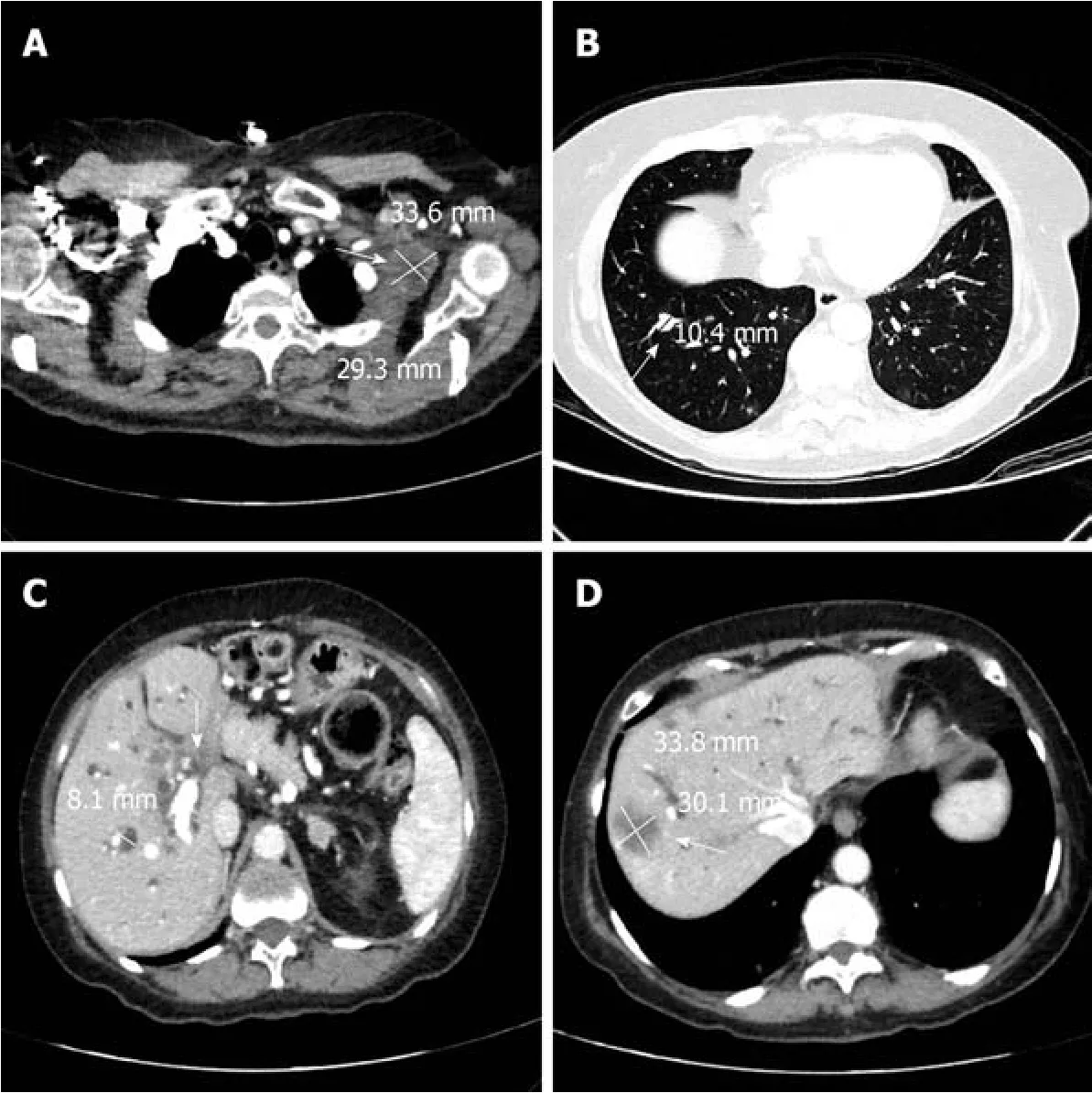Aeromonas veronii biovar veronii and sepsis-infrequent complication of biliary drainage placement:A case report
2019-04-17ManlioMontiAriannaTorriElenaAmadoriAliceRossiGiuliaBartoliniChiaraCasadeiGiovanniLucaFrassineti
Manlio Monti,Arianna Torri,Elena Amadori,Alice Rossi,Giulia Bartolini,Chiara Casadei,Giovanni Luca Frassineti
Abstract
Key words:Aeromonas veronii biovar veronii;Aeromonas;Pancreatic cancer;Cholangitis;Sepsis;Biliary tract infection;Case report
INTRODUCTION
Aeromonasspecies are small,ubiquitous gram-negative bacilli isolated from a variety of environmental sources including water,seafood,meat and vegetables,and occasionally from the feces of healthy individuals.A review by Janda and Abbot[1]listed 21 publishedAeromonasspecies.This bacterium is a potential pathogen in gastroenteritis and in a wide spectrum of extraintestinal infections,including wound infection pneumonia,hemolytic uremic syndrome (HUS),peritonitis,biliary sepsis and septicemia[2].Aeromonasplays an important role in biliary duct infection in South East Asia because recurrent pyogenic cholangitis is prevalent in this region.The condition is characterized by multiple intrahepatic bile duct stones,strictures and dilations and recurrent attacks of septicemia.The consumption of raw seafood contaminated by theAeromonasspecies may also contribute to the development of septicemia.Aeromonas,although not a common pathogen in biliary sepsis,has an overall mortality rate of 25% to 75%[3].According to some case reports,this species causes around 3% of all cases of cholangitis in Asia[4]and even fewer cases in the Western world.We describe a case of severe sepsis fromAeromonas veronii biovar veronii(A.veronii biovar veronii) following biliary drainage in an Italian patient with advanced pancreatic cancer.
CASE PRESENTATION
Chief complaints
In August 2017 a 64-year-old Caucasian woman was urgently admitted to the Oncology Ward of our institute with jaundice.She had also been suffering from increasing dyspepsia and asthenia for the previous few weeks.
History of past illness
In August 2013 the patient had undergone pancreaticoduodenectomy and cholecystectomy for pancreatic adenocarcinoma with positive surgical margins.Between May 2014 and July 2017,she underwent three lines of palliative chemotherapy.
Personal and family history
Her personal and family history did not reveal anything significant.
Physical examination upon admission
Physical examination upon admission was unremarkable except for jaundice.
Laboratory examinations
Laboratory exams showed a white blood cell count of 8.51 × 109/L (reference range 4.0-10.0) with 74.3% neutrophils,17.4% lymphocytes and 7.6% monocytes.Hemoglobin was 11.9 g/dL (12-15.5) and platelets 374 × 109/L (140-400).The prothrombin time (international normalized ratio,INR) was 1.31 (0.80-1.20) and the activated partial thromboplastin time ratio was 0.94 (0.8-1.2).Electrolyte and renal function tests were normal.In particular,creatinine was 0.73 mg/dL (0.5-1.0) and velocity of glomerular filtration (eGFR) was 87 mL/min/1.73m2,while protein C reaction (PCR) was 509 mg/dL (< 5.0).Conversely,total bilirubin was 16.39 mg/dL (<1.20),direct bilirubin 13.61 mg/dL (< 0.30),aspartate transaminase 183 U/L (< 32),alanine transaminase 169 U/L (< 33),alkaline phosphatase 543 U/L (35-104),gammaGT 1019 (5-36) and lactate dehydrogenase 247 U/L (135-214).Tests for hepatitis B and C were negative,as was rectal screening for multiresistant gramnegative bacteria performed as a precautionary measure when the patient was admitted.
Imaging examinations
A total body computed tomography (CT) scan confirmed the metastases in the lungs,chest,abdominal lymph nodes,liver and hepatic hilar area (Figure 1).There was also marked ectasia of the intrahepatic bile ducts of both hemisystems.Six d after admission the patient underwent difficult placement of a percutaneous transhepatic external biliary catheter in the left hemisystem.A week later the catheter was checked for leakage because total bilirubin had not fallen below 11.8 mg/dL and was found to have become dislodged from the liver.The procedure was repeated and a new internal-external device was inserted.The following day the patient experienced severe abdominal pain,in particular in the upper right quadrant,with negative Blumberg’s and positive Murphy’s signs.An abdominal CT scan excluded acute radiological or surgical complications.The patient also had an isolated episode of fever (38.2 °C),and complained of left chest pain.She felt restless but fatigued at the same time,and there was an evident worsening of her clinical conditions.Blood cultures were performed on blood drawn from the peripheral and central venous catheters.The patient was immediately given paracetamol 1000 mg and started empiric intravenous antibiotic therapy with levofloxacin 500 mg/d for five d.Intravenous fluids were increased to 1500 mL/d.The following day oral steroid therapy with prednisone 25 mg was substituted with intravenous dexamethasone 8 mg.Two d after the insertion of the new catheter,hemoglobin was 10.5 g/dL,white blood cell count 13.65 × 109/L,platelets 29 × 109/L,creatinine 1.93 mg/dL and eGFR 27 mL/min/1.73/m2.The clinical chemistry laboratory noted that the creatinine value of 1.93 mg/dL was probably underestimated because of the presence of jaundice.The next day hemoglobin was 10.6 g/dL,white blood cell count 9.13 × 109/L,platelets 14× 109/L,creatinine 1.11 mg/dL and eGFR 52 mL/min/1.73m2.Given the worsening thrombocytopenia,the patient received a pool of platelets and,when the blood culture results revealed the presence ofA.veronii biovar veronii[sensitive to amikacin,minimal inhibitory concentration (MIC) ≤ 2;cefotaxime,MIC ≤ 1;ceftazidime,MIC ≤1;gentamycin,MIC ≤ 1;and ciprofloxacin,MIC ≤ 0.25],moderately sensitive to imipenem and piperacillin/tazobactam,and resistant to amoxicillin/clavulanic acid],levofloxacin was replaced with ceftazidime 2 g three times/d.We excluded disseminated intravascular coagulation (DIC) because the INR was 1.21 (0.8-1.2),fibrinogen 846 mg/dL (150-400),D-dimer 536 μg/L (cut-off for thrombosis 200 μg/L)and antithrombin 91% (70-150) while PCR was 84 mg/dL.A cytomegalovirus blood test was < 120 IU/mL and thus considered negative,while second-level hematochemical exams revealed anisocytosis,poikilocytosis,slight erythrocyte fragmentation and some myelocytes.Frequent blood tests were performed to exclude DIC.The number of platelets progressively increased but hemoglobin decreased to 7.7 g/dL and Coombs test was negative.The patient thus received a blood transfusion.Total bilirubin decreased to 7.61 mg/dL and the patient’s performance status gradually improved.
FINAL DIAGNOSIS
The patient with advanced pancreatic cancer and biliary obstruction developed sepsis caused byA.veronii biovar veronii.
TREATMENT
The patient with sepsis was treated with antibiotic therapy,first with levofloxacin then with ceftazidime and platelet and blood transfusions.

Figure1 A total body computed tomography scan confirmed the metastases in the lungs,chest,abdominal lymph nodes,liver and hepatic hilar area.
OUTCOME AND FOLLOW-UP
The patient was discharged in stable conditions after 10 d of ceftazidime to continue the best supportive care at home,including a further 4 d of the antibiotic therapy.The patient was alive at a distance of one mo from discharge but then was lost to followup.
DISCUSSION
Of the numerousAeromonasspecies,few have been related unquestionably to human extraintestinal infections[5]by virtue of their isolation in pure culture from sterile sites.Sepsis is perhaps the most relevantAeromonasinfection in terms of severity and frequency and is associated predominantly with several underlying diseases.Individuals with hepatobiliary diseases are particularly susceptible to the infections[6,7].In patients with hematologic diseases or solid tumors,antineoplastic drugs may induce alteration of gastrointestinal mucosa and allow transmigration of colonizedAeromonasspecies from the bowel into the circulatory system[8].The role ofA.veronii biovar veroniiin human sepsis has been described very rarely.Abbottet al[9]reported the first case ofA.veronii biovar veroniisepsis in an elderly man with advanced colorectal cancer who developed jaundice.The patient had multisystem organ failure two d after admission and died.In a subsequent report[10],A.veronii biovar veroniiwas responsible for bacteraemia and necrotizing fasciitis in a diabetic patient also affected by aAeromonas veronii biovar sobriaurinary tract infection.The potential portals of entry forAeromonasbacteria are the gastrointestinal tract,skin lesions,previous surgery or local trauma in an aqueous environment.The pathogenic mechanism ofAeromonasis multifactorial because many virulence factors are involved,including the production of cytotoxins.These toxins can cause diarrhea[11]or hemorrhagic colitis,and may play a role in HUS[12].In our patient,theA.veronii biovar veroniiinfection was responsible for monomicrobic cholangitis and was probably caused by the insertion of a percutaneous transhepatic biliary catheter.Few cases of sepsis fromAeromonashave been described in Western countries.Dryden and Munro[13]described 13 cases ofAeromonas-related septicemia (10 fromAeromonas sobriaand 3 fromAeromonas hydrophila),some of which had biliary tract as the primary site of infection.In the United States,Clark and Chenoweth[14]reported 15 cases ofAeromonasinfection of the hepatobiliary system but none were related toA.veronii biovar veronii.In France,Doudieret al[15]described 2 cases of septicemia caused byAeromonas cavieandAeromonas hydrophilafollowing the placement of transhepatic biliary drainage.
Of note,the routine prophylaxis with ampicillin-sulbactam (or clindamycin and gentamycin for penicillin-allergic patients) before the percutaneous biliary drainage procedure was not done in our patient,an oversight on our part.The patient did not recall having had any contact with potentially contaminated water or food products before admission to hospital,she had not traveled abroad in the recent past,and there were no other cases of this infection in the hospital.The rapid manifestation of symptoms after the second drainage would thus seem to indicate a correlation with the invasive procedure.
The abdominal pain,fever and laboratory alterations in our patient were attributable to sepsis.Although highly improbable,we also considered HUS in the differential diagnosis.Only a few cases of HUS fromAeromonashave been described worldwide,with diarrhea as the common feature and sometimes the need for dialysis or hemofiltration.We were unable to confirm or refute HUS because specific laboratory tests for the condition such as polymerase chain reaction assay for shigalike toxin genes and verotoxin test were not routinely performed.
Patients withAeromonasare susceptible to aminoglycosides,quinolones,cotrimoxazole and aztreonam,but are resistant to broad-spectrum cephalosporins becauseAeromonashas a propensity to produce at least 3 β-lactamases[1].We initially used levofloxacin because the patient recalled having had a positive allergic reaction to an antibiotic in the past but could not remember its name.However,she had previously taken levofloxacin without problems.In our caseAeromonas veroniiwas resistant to amoxicillin/clavulanic acid and moderately sensitive to imipenem.Of note,Sánchez-Céspedes[16]reported a resistance to imipenem in case ofAeromonas veronii biovar sobria,which should alert clinicians to the possible emergence of multidrug-resistance.
We describe a case of monomicrobic infection,cholangitis and sepsis caused byA.veronii biovar veronii,a rare event in humans.In fact,as far as we know,this is the first reported case of sepsis fromA.veronii biovar veroniifollowing biliary drainage in Western countries.It seems logical to hypothesize that theAeromonasinfection in our patient was related to the invasive biliary tract procedure which may have facilitated an ascending infection from intestinal bacteria.Our findings confirm the sensitivity of the bacterium to third-generation cephalosporins,aminoglycosides,quinolones,but the moderate sensitivity to imipenem and piperacillin/tazobactam is potentially indicative of future resistance to these antibiotics.
CONCLUSION
Our study highlights thatAeromonasinfection can lead to life-threatening clinical conditions and significant laboratory alterations.Biliary drainage can cause cholangitis and antibiotic prophylaxis is recommended a priori for this surgical maneuver.The presence of an infection fromAeromonasshould also alert clinicians to the possibility of severe sepsis.
ACKNOWLEDGEMENTS
The authors thank Gráinne Tierney and Cristiano Verna editorial assistance.
杂志排行
World Journal of Clinical Cases的其它文章
- Unexplained abdominal pain due to a fish bone penetrating the gastric antrum and migrating into the neck of the pancreas:A case report
- Photodynamic therapy as salvage therapy for residual microscopic cancer after ultra-low anterior resection:A case report
- Effective chemotherapy for submandibular gland carcinoma ex pleomorphic adenoma with lung metastasis after radiotherapy:A case report
- Primary hepatic follicular dendritic cell sarcoma:A case report
- Multiple gastric angiolipomas:A case report
- Lump type crossed fused renal ectopia with bilateral vesicoureteral reflux:A case report
